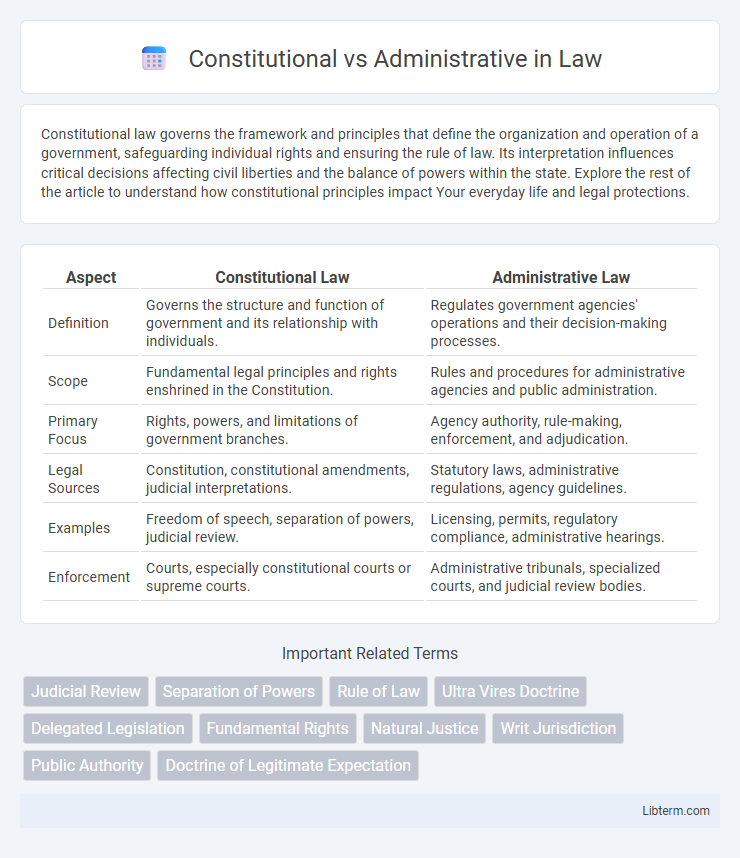Constitutional law governs the framework and principles that define the organization and operation of a government, safeguarding individual rights and ensuring the rule of law. Its interpretation influences critical decisions affecting civil liberties and the balance of powers within the state. Explore the rest of the article to understand how constitutional principles impact Your everyday life and legal protections.
Table of Comparison
| Aspect | Constitutional Law | Administrative Law |
|---|---|---|
| Definition | Governs the structure and function of government and its relationship with individuals. | Regulates government agencies' operations and their decision-making processes. |
| Scope | Fundamental legal principles and rights enshrined in the Constitution. | Rules and procedures for administrative agencies and public administration. |
| Primary Focus | Rights, powers, and limitations of government branches. | Agency authority, rule-making, enforcement, and adjudication. |
| Legal Sources | Constitution, constitutional amendments, judicial interpretations. | Statutory laws, administrative regulations, agency guidelines. |
| Examples | Freedom of speech, separation of powers, judicial review. | Licensing, permits, regulatory compliance, administrative hearings. |
| Enforcement | Courts, especially constitutional courts or supreme courts. | Administrative tribunals, specialized courts, and judicial review bodies. |
Introduction to Constitutional and Administrative Law
Constitutional law establishes the fundamental principles and framework of government, defining the powers and duties of governmental institutions and the rights of individuals. Administrative law governs the activities of public agencies, ensuring legality, fairness, and transparency in decision-making processes. Both fields are essential for maintaining the rule of law and balancing governmental authority with individual rights.
Definitions: Constitutional Law vs Administrative Law
Constitutional law governs the fundamental principles and structures of a state, defining the powers of government branches and protecting individual rights through a written or unwritten constitution. Administrative law oversees the activities and rule-making authority of government agencies, ensuring lawful implementation and enforcement of public policies. While constitutional law establishes the framework for legal authority, administrative law provides the mechanisms for executing and regulating this authority in daily governance.
Historical Development and Evolution
Constitutional law has evolved from ancient principles of governance and codified frameworks like the Magna Carta and the U.S. Constitution, establishing the fundamental structure and limits of government authority. Administrative law developed later, growing significantly during the 19th and 20th centuries in response to expanding governmental agencies and the need for regulatory oversight. The historical progression of administrative law reflects a shift from constitutional constraints to practical mechanisms ensuring bureaucratic accountability and procedure.
Key Principles and Foundations
Constitutional law establishes the fundamental principles governing the structure, powers, and limits of government, centered around the rule of law, separation of powers, and protection of individual rights. Administrative law focuses on the implementation and regulation of government policies through public agencies, emphasizing fairness, transparency, and accountability in administrative decisions. The key foundation of constitutional law lies in the supremacy of the constitution, while administrative law derives authority from enabling statutes and procedural norms.
Scope and Application
Constitutional law governs the fundamental principles and structures of a state, defining the powers and duties of government branches and protecting individual rights, applicable universally across all government actions. Administrative law specifically regulates the activities and procedures of government agencies, focusing on decision-making processes, rulemaking, and enforcement within the executive branch. The scope of constitutional law is broad and foundational, while administrative law operates within a narrower framework to ensure lawful implementation of policies and regulations.
Functions and Objectives
Constitutional law primarily focuses on establishing the framework of government, defining the separation of powers, and protecting fundamental rights and liberties of citizens. Administrative law governs the activities of government agencies, ensuring lawful, fair, and efficient decision-making in public administration. Both aim to regulate state power but differ in scope, with constitutional law providing foundational principles and administrative law managing day-to-day government functions.
Sources of Constitutional and Administrative Law
Constitutional law derives primarily from written constitutions, judicial interpretations, and fundamental statutes that establish the structure and principles of government. Administrative law is sourced from statutes enacted by legislatures, rules and regulations issued by administrative agencies, and court decisions reviewing administrative actions. Both bodies of law rely on judicial precedents, but constitutional law emphasizes fundamental rights and government powers, while administrative law focuses on agency regulation and procedural fairness.
Interrelationship and Distinctions
Constitutional law establishes the fundamental principles and framework of government, defining the powers and duties of institutions, while administrative law governs the implementation and regulation of these powers through government agencies. Their interrelationship lies in administrative law operating within the boundaries set by constitutional provisions, ensuring administrative actions comply with constitutional rights and limits. Distinctions emerge as constitutional law addresses broad governance structures and individual rights, whereas administrative law focuses on procedural rules, agency decision-making, and enforcement mechanisms within those constitutional parameters.
Landmark Cases and Legal Precedents
Landmark cases such as Marbury v. Madison (1803) established the principle of judicial review in constitutional law, defining the Supreme Court's role in interpreting the Constitution. In administrative law, Chevron U.S.A., Inc. v. Natural Resources Defense Council, Inc. (1984) set a crucial precedent for courts to defer to administrative agencies' interpretation of ambiguous statutes. These cases highlight the distinct but interconnected roles constitutional and administrative law play in shaping legal standards and government accountability.
Contemporary Issues and Future Trends
Contemporary issues in constitutional law include debates over individual rights, separation of powers, and judicial review, reflecting evolving interpretations of legal frameworks under global political shifts. Administrative law faces challenges in regulating emerging technologies, ensuring governmental transparency, and balancing regulatory authority with civil liberties in rapidly changing societal contexts. Future trends point toward increased reliance on digital governance, enhanced public participation, and adaptive legal mechanisms to address complexities in constitutional and administrative practices.
Constitutional Infographic

 libterm.com
libterm.com